An easy Thai-style watermelon rind curry recipe made in Instant Pot with readily available ingredients! Also, learn how to cook rice along with the curry using the pot-in-pot method in Instant Pot. A sustainable vegan curry that’s oh-so-delicious, even if I may say so myself.
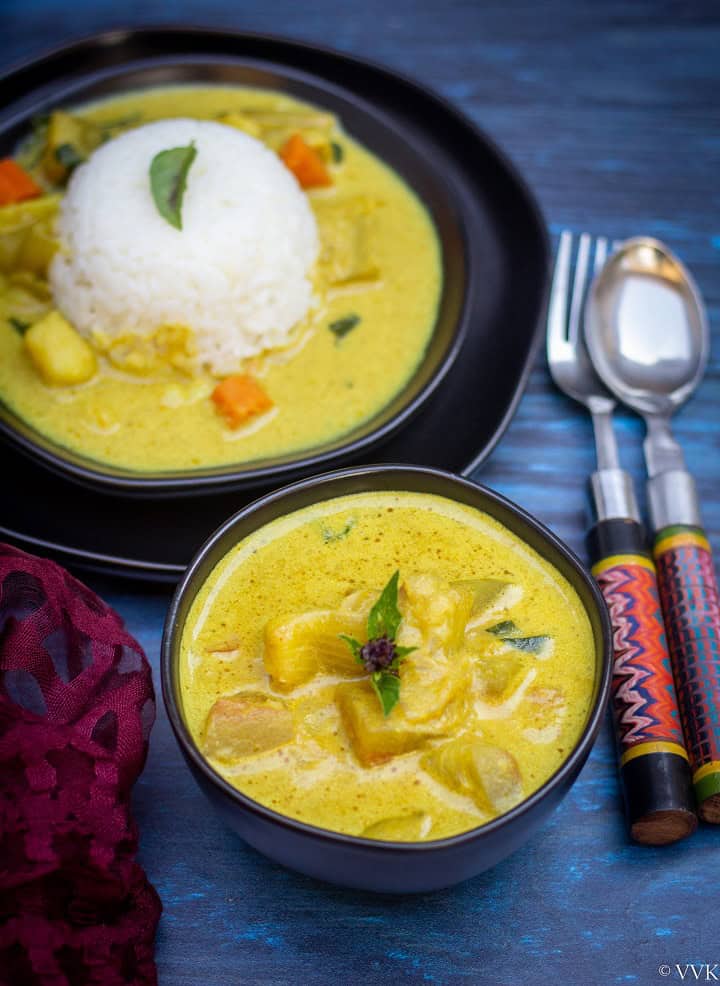
Have you ever thought of using watermelon rind in your cooking? If your answer is no, then this post will change your perspective. I can assure you that you won’t discard the watermelon rind from now on. :-)
Watermelon is a favorite summer fruit for most of us. Last week I shared watermelon juice and watermelon popsicles, and I had shared the health benefits of watermelon as well.
If you remember, I mentioned not to discard the watermelon rind and share some exciting recipes. And here I am with a delicious Thai-style watermelon rind curry.
Watermelon Rind-
This year, I am learning about sustainable cooking and how to use the veggies without any wastage efficiently. I have already shared how to use the pumpkin gut and make chutney and raita on my youtube channel, and for the chayote squash chutney, I had used the skin as well.
Cooking with watermelon rind is not unusual in Indian cooking. Watermelon rind dosa is quite popular in South India. You can treat watermelon rind like any other vegetable and make curries, gravies, stir-frys, and what not? I even shared another Watermelon rind curry recipe with Shan’s masala on my Instagram.
The possibilities are endless, and I hope you try different recipes with it. I will share some more recipes as well, but now let’s talk about this Thai-style curry.
Vegan Thai-Curry-
You all know how much I love Thai food, and I took the effort to source the traditional ingredients like galangal, kaffir lime to make my red curry, yellow curry, and green curry.
I always wanted to try Thai massaman curry, and last month when I was looking to it, the curry paste had ingredients that we use for our garam masala. That’s when I thought why not use garam masala or curry powder and make the curry paste. I know it’s not authentic, but trust me, folks, it works really well.
It’s a simple one-pot curry recipe that you can make it quite easily. All you have to do is make the curry paste, add everything to the Instant Pot, let the IP do its magic, and then add coconut milk and simmer it.
My homemade curry paste-
I had some frozen lemongrass (I bought a bunch this year beginning and froze some of them). So I used frozen lemongrass, basil leaves, curry powder, turmeric powder, and red chili powder and made the curry. Lemongrass is the key ingredient here. If you can’t source fresh lemongrass, go for the store-bought lemongrass paste.
Also, when I first tested this recipe, I used Thai basil from my backyard. But for this, I went with Italian basil. I know it’s hard to source Thai basil, so use whatever you have in hand.
This recipe is all about substitutes and readily available ingredients. I know in this current situation, we need to work with what we have. Please check my recipe notes for alternatives.
Cooking rice along with the curry in Instant Pot-
This watermelon rind curry is perfect for a quick weeknight dinner. It’s hard to resist rice and curry. :-)
With Instant Pot, you can cook the rice along with the curry. The pot-in-pot method comes in handy, and you can make dinner in no time. Add in some beans or tofu to make it a complete meal. I served it along with Teriyaki tofu, but you can add tofu pieces in this curry also.
I used the sticky rice variety for this, and for 1 cup of rice, I used 1.5 cups of water. I love mushy sticky rice, and this water measure worked for me. I cooked the curry and rice for 4 minutes at high pressure and released the pressure after 10 minutes. Both the rice and curry were perfectly cooked. Let the rice cool a bit before serving.
Watch me make the Thai curry-
Now without any further ado, let me share how I made this Thai curry in Instant Pot.
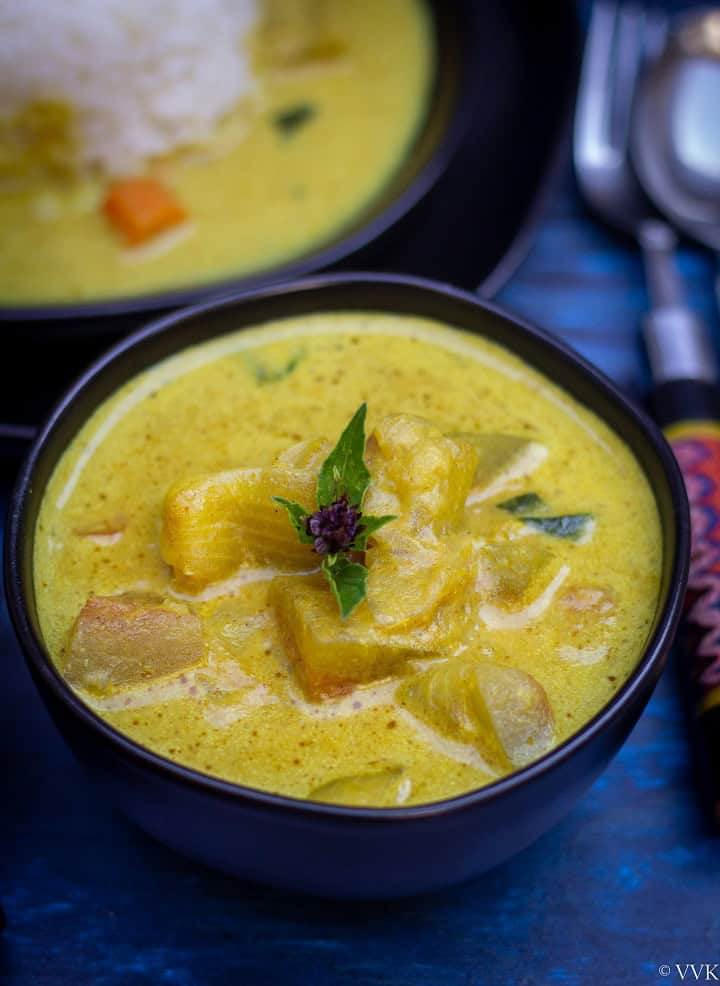
Prepare the curry paste-
- In a blender or mixer jar, add the lemongrass, 8 to 10 basil leaves, curry powder, turmeric powder, and red chili powder. Grind it into a smooth paste by adding ¼ cup of water.
Prepare the curry-
- Set the Instant Pot in sauté mode and add 2 tbsp sesame oil(can use any oil)
- When the oil is hot, add the chopped onions and saute for 2 minutes.
- Then add the chopped watermelon rind, followed by potatoes and carrots. (I had 120 grams of potatoes and carrots together)
- Now add the salt and ground curry paste. Add ½ cup of water to the blender or mixer jar and rinse it and add it to the curry.
- Mix well and turn off the Instant Pot
Cook the rice-
- In a bowl that fits inside the Instant Pot, add the rinsed rice and 1.5 cups of water.
- Place the egg rack or tall trivet in the Instant Pot, as shown in the video.
- Place the rice bowl on the trivet. And close the Instant Pot.
- Make sure the sealing ring is on, and the vent is in the sealing position. Pressure cook for 4 minutes at high-pressure mode and release the pressure quickly after 10 minutes.
Add coconut milk and simmer the curry-
- Once the cooking is complete, carefully open the Instant Pot lid. Take out the rice and egg rack/trivet carefully.
- Set the Instant Pot in saute mode. Add 1 cup of coconut milk, soy sauce, and brown sugar. Mix well.
- Add the remaining basil leaves and let the curry simmer for 5 minutes. At this stage, you can check for salt and spice and adjust accordingly.
- After 5 minutes, turn off the Instant Pot and serve the curry with rice.
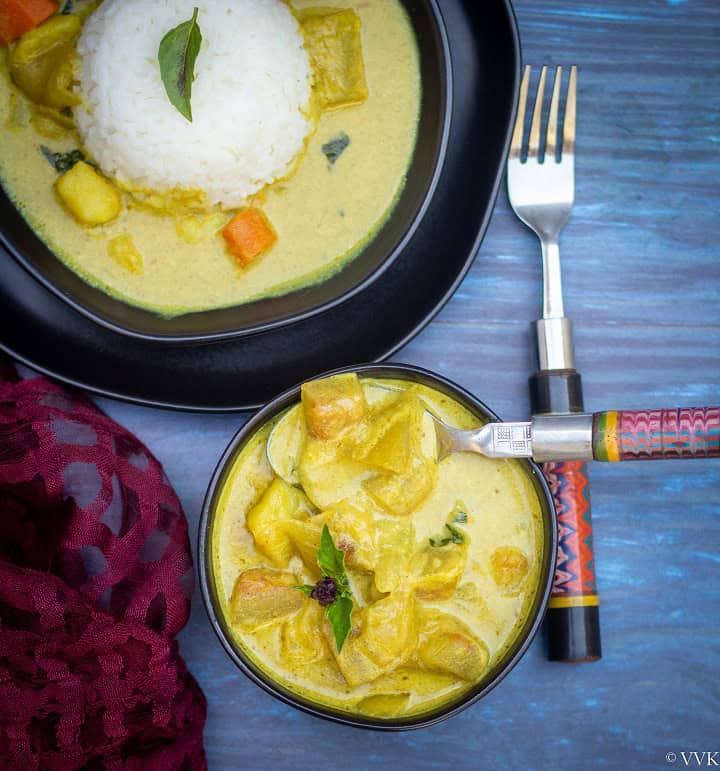
Recipe Notes-
- I served it with Teriyaki tofu, which added sufficient protein. But after cooking the curry, you can add pressed tofu cubes and simmer for 7 to 8 minutes and make it into a veggie and tofu curry.
- You can use oil of your choice instead of sesame oil.
- A little bit of red skin in the watermelon rind is ok, which adds sweetness to the curry. But you can always adjust the sugar amount as per your choice.
- I recommend thick or full-fat coconut milk for this curry instead of the light one.
- You can use Thai-basil instead of Italian sweet basil. In that case, reduce the basil leaves amount. 12 to 15 leaves are sufficient for this curry. But if you like the strong flavor of basil leaves, you can add more.
- I used frozen and thawed lemongrass, and it wasn’t strong enough, so I went with 12 grams. One stalk of fresh lemongrass or 1 to 1.5 tbsp of store-bought lemongrass paste would be sufficient for this measure.
- If you can’t source lemongrass, then 1.5 tsp of lime zest and 1 tbsp of lime juice instead.
- Instead of this curry paste, you can use store-bought red curry paste or green curry paste and use it.
- I did not include any cilantro. But you can use cilantro stems while making the curry paste and also some leaves to garnish.
- Also, use veggies of your choice.
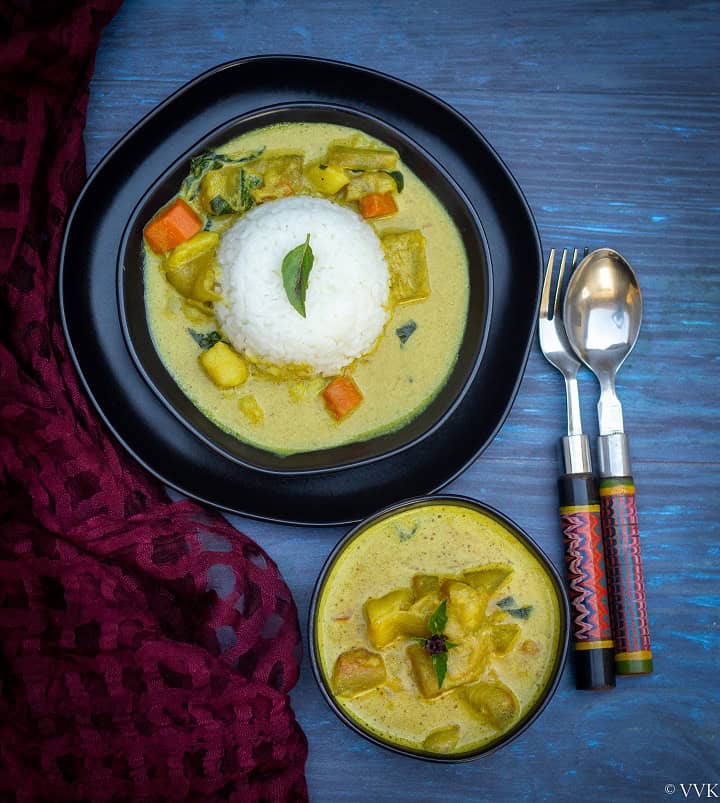
Looking for another creative way to use watermelon rind? Try this Watermelon Rind Dosa | Kalingana Polo recipe, a delicious and unique dosa made with the often discarded watermelon rind. It pairs perfectly with this curry!
Other Vegetarian Curries-
PS: Follow me on Instagram or join my Facebook Group for more gardening and recipe updates. If you try this Thai-style watermelon rind curry, please don’t forget to comment and rate this recipe. If you have any questions, please leave a comment, and I will get to it asap. Make sure to follow me on my Pinterest for more healthy and delicious ideas!
📖 Recipe
Thai-Style Watermelon Rind Curry | Vegan Instant Pot Thai Curry
Equipment
- Instant Pot or Pressure Cooker
Ingredients
Measurement Details: 1 cup=240ml; 1 tbsp=15ml; 1 tsp=5ml;
For the curry paste-
- 12 grams lemongrass chopped
- 15 to 20 Italian Basil Leaves divided
- 1 tbsp curry powder
- ¼ tsp turmeric powder
- ¼ tsp red chili powder optional
- ¼ cup water
For the curry-
- 2 tbsp sesame oil
- 120 grams onion chopped into wedges/petals
- 250 grams watermelon rind peeled and cut (a little red part is ok)
- 1 potato peeled and cut
- 1 carrot peeled and cut
- 1.5 tsp salt or to taste
- ½ cup water
- 1 cup coconut milk thick one. (I used Choakoh brand)
- 1 tbsp brown sugar
- 1 tsp soy sauce
For the rice
- 1 cup jasmine/ sticky rice rinsed and soaked for 10 minutes
- 1.5 cups of water
Instructions
- Prepare the curry paste - In a blender or mixer jar, add the lemongrass, 8 to 10 basil leaves, curry powder, turmeric powder, and red chili powder. Grind it into a smooth paste by adding ¼ cup of water.
- Prepare the curry - Set the Instant Pot in dauté mode and add 2 tbsp sesame oil(can use any oil)
- When the oil is hot, add the chopped onions and saute for 2 minutes.
- Then add the chopped watermelon rind, followed by potatoes and carrots. (I had 120 grams of potatoes and carrots together)
- Now add the salt and ground curry paste. Add ½ cup of water to the blender or mixer jar and rinse it and add it to the curry.
- Mix well and turn off the Instant Pot
- Cook the rice - In a bowl that fits inside the Instant Pot, add the rinsed rice and 1.5 cups of water.
- Place the egg rack or tall trivet in the Instant Pot, as shown in the video.
- Place the rice bowl on the trivet. And close the Instant Pot.
- Make sure the sealing ring is on, and the vent is in the sealing position. Pressure cook for 4 minutes at high-pressure mode and release the pressure quickly after 10 minutes.
- Add coconut milk and simmer the curry - Once the cooking is complete, carefully open the Instant Pot lid. Take out the rice and egg rack/trivet carefully.
- Set the Instant Pot in saute mode. Add 1 cup of coconut milk, soy sauce, and brown sugar. Mix well.
- Add the remaining basil leaves and let the curry simmer for 5 minutes. At this stage, you can check for salt and spice and adjust accordingly.
- After 5 minutes, turn off the Instant Pot and serve the curry with rice.
Video
Notes
- I served it with Teriyaki tofu, which added sufficient protein. But after cooking the curry, you can add pressed tofu cubes and simmer for 7 to 8 minutes and make it into a veggie and tofu curry.
- You can use oil of your choice instead of sesame oil.
- A little bit of red skin in the watermelon rind is ok, which adds sweetness to the curry. But you can always adjust the sugar amount as per your choice.
- I recommend thick or full-fat coconut milk for this curry instead of the light one.
- You can use Thai-basil instead of Italian sweet basil. In that case, reduce the basil leaves amount. 12 to 15 leaves are sufficient for this curry. But if you like the strong flavor of basil leaves, you can add more.
- I used frozen and thawed lemongrass, and it wasn't strong enough, so I went with 12 grams. One stalk of fresh lemongrass or 1 to 1.5 tbsp of store-bought lemongrass paste would be sufficient for this measure.
- If you can't source lemongrass, then 1.5 tsp of lime zest and 1 tbsp of lime juice instead.
- Instead of this curry paste, you can use store-bought red curry paste or green curry paste and use it.
- I did not include any cilantro. But you can use cilantro stems while making the curry paste and also some leaves to garnish.
- Also, use veggies of your choice.
Nutrition
I am not a nutritionist. The nutritional information is provided as a courtesy and is an estimate only. It varies depending upon the product types or brands.



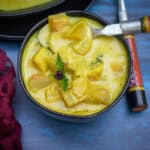



I’ve made this recipe several times over the past year. It’s seriously one of my favorite recipes. Everybody I’ve given it to is so surprised by how much they like it. Even my daughter loves this. She actually asked to eat it and for me to make it for her. I leave out the brown sugar because it’s sweet enough without it, and I use coconut amino sauce in place of soy sauce because my mother-in-law can’t have sauce. I usually make it without lemongrass only because I don’t have lemongrass on hand normally.
Thanks so much. Glad you liked it. Thanks for sharing the variations.
If I use store-bought curry paste instead of making my own, how much does the recipe require? 2 to 3 tablespoons?
I would start with 2 tbsp. Depending upon the spice level and if needed you can add more and simmer it again. I hope this helps. Thanks
I have a question about the rind ..
Can you use the green part of the rind?
No, the green part of the rind is not edible. So you need to discard that.